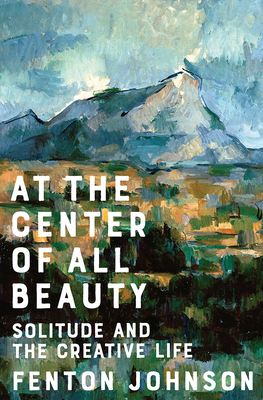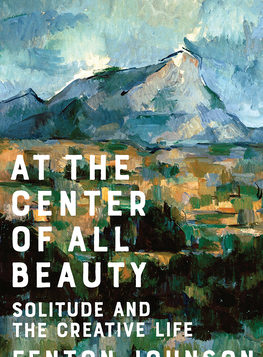 AT THE CENTER OF ALL BEAUTY
AT THE CENTER OF ALL BEAUTY
Solitude and the Creative Life
by Fenton Johnson
Norton, 236 pages, $26.95
THIS BOOK is as unclassifiable as Thoreau’s Walden, whose author is the subject of one of its chapters. Part memoir, part critical study of writers and artists, part queer manifesto, At the Center of All Beauty is about Fenton Johnson’s effort to live deliberately, which in his case means alone. Johnson was born and raised in rural Kentucky, the youngest of nine children. His family lived on the Catholic side of the Rolling Fork River, near the Abbey of Gethsemani, home of Thomas Merton, and the farm where Abraham Lincoln was born. Johnson’s father worked at a nearby Seagram’s distillery. Protestants lived on the other side of the river. His father’s Catholicism instilled in him a love of tradition; his mother’s Protestant roots inclined him to rebellion. But what brought Fenton Johnson to solitude was his “fundamentally bent self,” his outsider status as a gay man.
Johnson has published three novels set in Kentucky and several books of nonfiction. His powerful 1996 memoir Geography of the Heart, about coming to love a man who died of AIDS, won a Lambda Literary Award. In his new book, he sets out to explore his life-long attraction to solitude by studying the lives and works of famous “solitaries,” a term he borrows from Merton. His list of subjects includes the expected (Thoreau, Emily Dickinson, Henry James), the surprising (Rod McKuen, Nina Simone, Bill Cunningham), and the non-Western (Rabindranath Tagore, an Indian writer and educator).
Throughout the book, he moves back and forth between events in his own life and the lessons he has learned from the lives of creative people who embraced being alone. Early on he states: “I try to stay present to my past.” Indeed, Johnson writes best when he writes about himself: his relationship with his parents, who provided a model of how to be solitary within a marriage; his idyllic childhood; his need to leave Kentucky for California, where he could pursue his desire to become a writer and discover a life as a gay man.
The book opens with Johnson in the seventh grade, assigned by Sister Marie-Therese to draw a poster illustrating a lesson from his Roman Catholic catechism. He chooses to draw the “Three Roads to Heaven,” the vocations available to him when he grows up: religious life, marriage, or remaining single. In the pages that follow, Johnson will argue that being single is a life calling, “a particular and urgent summons from a force greater than individual need or choice.” This summons can be difficult to follow. People who remain single are likely to encounter the pity and even disapproval of the community.
Although he uses religious language, Johnson admits that, like his father, he “cannot stand religion.” The language, however, is a means for him to describe the struggle of his solitary subjects to reach the center of beauty in their art and to share what amounts to a mystical vision, not with just one person but with everyone. By serving others in this fashion, solitary artists resemble what Johnson calls “secular monks.” His own moment of transcendence comes when he imagines himself looking down on the flagstone patio of his childhood home and seeing his family and friends, many now deceased, gathered there once again. “In what manner, please, are those people absent and gone, when they make up the very stuff of me and now you, in the miraculous way of words in print?” For Fenton Johnson, the bond between writer and reader mirrors the “interconnectedness of all being.”
The thread that links the writers and artists that Johnson explores is the outsider perspective that pushed each of them to see beyond a conventional response to life. This status can be based on conscience (Thoreau), artistic vision (Paul Cézanne), sexual orientation (Whitman, Henry James, Rod McKuen, Bill Cunningham), gender (Emily Dickinson), race (Zora Neale Hurston, Nina Simone), even physical appearance (Eudora Welty). Because he pushes beyond the usual ways of understanding his subjects, what Johnson has to say about them can be startling. In this regard, his rebellious streak stands him in good stead. On the other hand, that streak may also disturb some readers. Johnson makes a case for celibacy, and he has harsh things to say about gay assimilation, American consumerism, and the flaws of “fortress marriage,” which raise a wall between members of the family and a world that is perceived to be evil or threatening.
In this beautifully written book, Johnson’s aphoristic prose is at times the equal of Thoreau’s. A passage near the end of the book in which he imagines his death is a sublime piece of writing, ending with this sentence: “There you will find my body come the cold, bright blue morning, leaning against the great mottled sycamore tree of my dreams, happy to have left this world as I came into it, alone but not alone, content to join the company of those who have gone before, who made me who I am and who welcomed me back with open arms to our true and perfect home.” As I became engrossed in the stories from Johnson’s life, his rapturous vision of what art can do, his argument on behalf of silence and the rewards of spending time alone, I couldn’t help but wonder one thing. What about ordinary people, those who are not artists, who do not have a genius for words or music, painting or photography, to which they can devote their lives? Reading At the Center of All Beauty, I came to see that each of us, single or coupled, has access to an interior life, a center of beauty, if only, as Johnson forcefully argues, we are not afraid of silence, of listening, of solitude, and what they have to teach us.
Daniel A. Burr, who lives in Covington, Kentucky, is a frequent contributor to this magazine.






